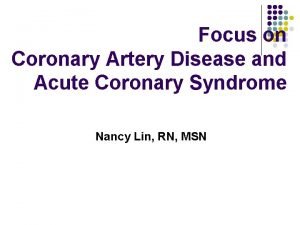Paediatric Acute Pericarditis in University Hospital within Years

- Slides: 1

Paediatric Acute Pericarditis in University Hospital within Years 2008 -2017 (10 year review) ID 23406 Ligere E. 1, 2, , Bergmane I. 1, Matsate-Matsone B 1. , Lubaua I. 1, 2, Lace I. 1, 2, Smits L 1. , Sikora N 1. , Ozolins V 1. 1 Department f of Paediatric Cardiology and Cardiac Surgery, University Hospital for Children, Riga, Latvia. 2 Department of Paediatrics, Riga Stradins University, Riga, Latvia Acute pericarditis (AP) in children is a rare disease and most often has infectious aetiology but can also arise from autoimmune and malignant causes. The diagnosis is often delayed because of nonspecific clinical signs. 3, 5 There were 15 cases of AP diagnosed during hospitalization. One case was excluded from the further study due to myopericarditis with the prevalence of myocardial inflammation. There were 3 cases with non-infectious causes: mediastinal Hodkin`s lymphoma, thrombotic thrombocytopenic purpura and Stills disease with mastocyte activation syndrome. Patients with infectious acute pericarditis were 5 girls and 6 boys (55%), age 8± 5 years, 7 patients (64%) were transferred from other hospitals and 82%(9) had received antibiotics before admission to our hospital. The amount of pericardial fluid diagnosed by echocardiography at the moment of diagnosis was 25± 13 mm, CRP 84± 77 mg/L, leucocytes’ count 10. 7± 5 thousand. Causative agents were found in 7 cases (64%): (1 - tbc, 1 - parvo B 19, 1 -EBV, 1 -RSV, 1 -CMV, 1 -S. aureus, 1 Varicella). Pericardial drainage was performed in 82%(9). There were no cases of death. The length of hospital stay was 33± 18 days. Recurrent pericarditis was observed in 3 patients (27%) (2 -3 episodes). 3 3 2, 5 2 Circular pericardial effusion in a 9 year old patient 1, 5 1 0, 5 0 2 2 1 1 Cases of acute pericarditis per year 0 2008 2009 2010 2011 2012 2013 2014 2015 2016 2017 The objectives of the study were to analyse all cases of AP treated in our hospital during years 2008 -2017. AP remains serious disease with complicated diagnosis due to inapparent clinical signs up to the collection of large pericardial effusion which develop within days to weeks. It is necessary to take blood cultures prior administration of antibiotics in unclear cases. All the cases with AP were selected from hospitals database. We analyzed case histories to explore the course of disease, causative agents, echocardiographic findings, surgical interventions and the outcome.

